The benefits and harms of radishes for the human body
During spring and early summer, nutritionists definitely recommend including radishes in the diet. Fruits contain few calories (20 kcal per 100 g) and fats, but they are useful from the point of view of medicine, since they contain vitamins of different groups, mineral salts. As a medicinal raw material, not only root crops are used, but also tops. It contains calcium, potassium, magnesium, fluorine, iron, vitamin A, nicotinic and salicylic acids, and other components necessary for the correction and maintenance of health in general.
From the article you will learn what the benefits and harms of radishes are for the human body, what are its nutritional properties, rules and norms of use, who and when can and should eat radishes, and to whom the vegetable is contraindicated, as radishes are used in cooking and traditional medicine.
The content of the article
Radish - composition, benefits and harms
Radish is an edible plant cultivated in almost all countries of the world... Valued as an early vegetable: the first harvest of greenhouse radish can be obtained in April. They use both fresh root vegetables and tops as an ingredient in okroshka, salad, and soup.
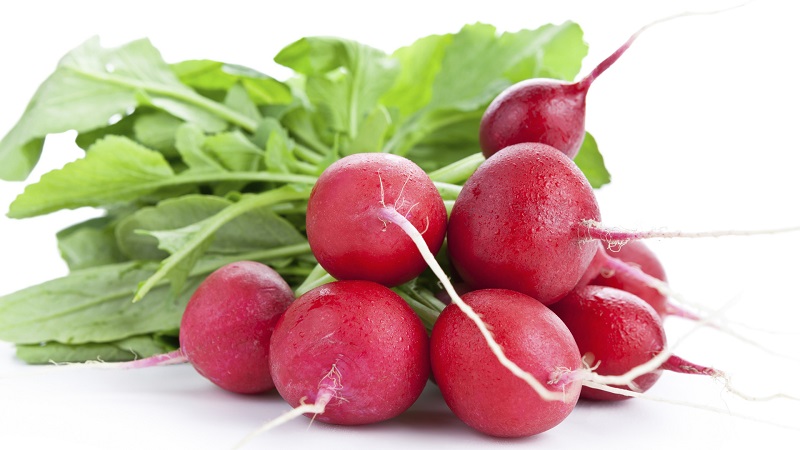
High content in different parts of the vegetable The vitamins, micro- and macroelements necessary for the human body determine the use of radish in the treatment and prevention of diseases of the cardiovascular, digestive, and urinary systems.
Composition
Radish root crops are 93% water, the remaining 7% are:
- alimentary fiber;
- starch;
- ash;
- thiamin (vitamin B1);
- riboflavin (vitamin B2);
- choline (vitamin B4);
- pantothenic acid (vitamin B5);
- pyridoxine (vitamin B6);
- folic acid (vitamin B9);
- ascorbic acid (vitamin C);
- alpha tocopherol (vitamin E);
- phylloquinone (vitamin K);
- vitamin PP;
- niacin;
- trace elements: iodine, copper, iron, cobalt, boron, lithium, vanadium, aluminum, nickel, manganese, molybdenum, chromium, selenium, fluorine, zinc;
- macroelements: phosphorus, chlorine, magnesium, sodium, calcium, potassium, silicon, sulfur;
- nonessential and essential amino acids;
- easily digestible sugars;
- saturated and polyunsaturated fatty acids.
The chemical composition of radish leaves contains the same ingredients, as the fruits, only in higher doses, therefore, the tops as a medicinal raw material is of great value in folk medicine.
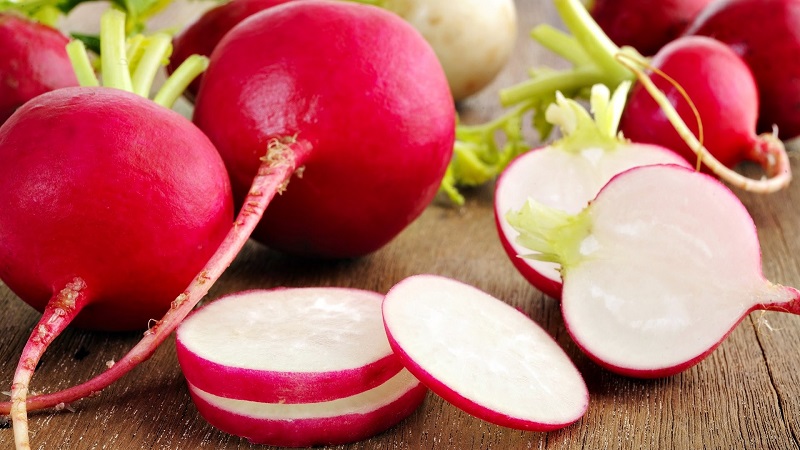
Benefit and harm
Due to its varied chemical composition fruits and greens of vegetables have a beneficial effect on the body, satisfy the body's needs for vitamins of group B, C, E, K, PP, micro- and macroelements, maintain and improve the functionality of organs and organ systems.
Useful properties of radish:
- promotes weight loss;
- normalizes metabolism;
- slows down the aging process;
- has antioxidant properties;
- strengthens and increases the elasticity of the vessel walls;
- normalizes blood circulation processes;
- has wound healing properties;
- prevents the penetration, growth and reproduction of pathogenic infections in the body;
- protects against atherosclerosis;
- activates the digestive system;
- enhances intestinal peristalsis;
- increases the secretion of gastric juice;
- reduces cholesterol levels;
- regulates blood sugar levels;
- cleanses the body of toxins and toxins;
- slows down growth and prevents the formation of cancer cells, which serves as a good prevention of cancer;
- increases the body's defenses;
- increases the production and secretion of bile, reduces its stagnation;
- removes excess fluid and salt from the body, thereby reducing puffiness.
There are also negative aspects.... When you have an upset bowel, radish meals can aggravate your symptoms because the vegetable has some laxative effect. In case of gastric ulcer, gastritis, enterocolitis, acids in the composition of fruits cause mechanical and chemical irritation of the gastrointestinal mucosa, which is manifested by a relapse of the disease, increased pain, deterioration of the general state of health.
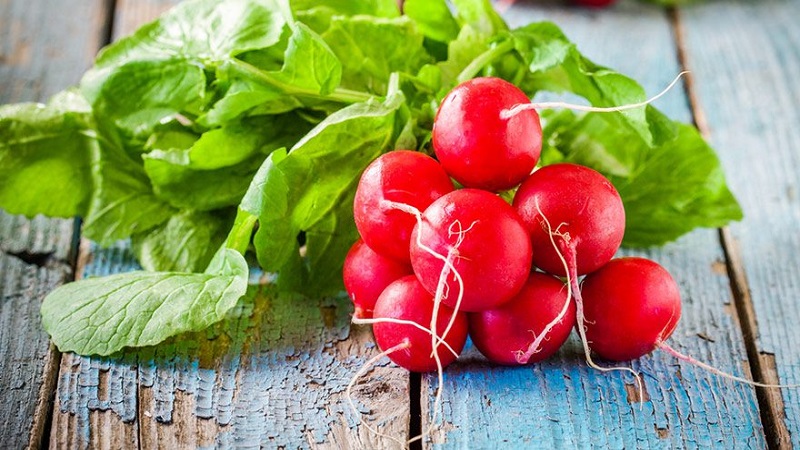
Cyanogenic glycosides were found in the fruit, which aggravate the course of diabetes mellitus, have a toxic effect, can cause dysfunction of the endocrine gland, pathological enlargement of the thyroid gland (goiter formation). A large amount of a vegetable is hard on the stomach, takes a long time to digest in the intestines and can cause such unpleasant sensations as bloating, a feeling of fullness, an unpleasant sensation of food retention in the stomach.
Read also:
What vitamins are contained in radishes
The best varieties of radish for open ground and greenhouses
Calorie content and BZHU
Fruits are classified as low-calorie foods.... 100 g of radish contains: 20 kcal, protein - 1.2 g, fat - 0.1 g, carbohydrates - 3.4 g.
Useful properties of radish for organs and various body systems
Root vegetables contain a lot of fiber, which plays a huge role in maintaining the life of the body. Dietary fiber slows down the absorption of carbohydrates, fats and proteins, which can be beneficial for weight loss. In addition, when entering the intestines, the fibers swell, fill the free space, due to which a quick saturation occurs. The feeling of satiety persists for a long time, due to which the next serving volume decreases, there is no need for snacks.
For reference. Scientists have found that eating 210 grams of fiber-containing vegetables and fruits daily reduces the risk of death from cardiovascular disease by 40%.
Essential oils present in root vegetables, have a bactericidal effect, serve as a good prevention of infectious diseases, ARVI, ARI. Vitamins, micro- and macroelements in a complex strengthen the immune system, remove toxins and toxins from the body, improve complexion and skin condition, increase endurance and work capacity.
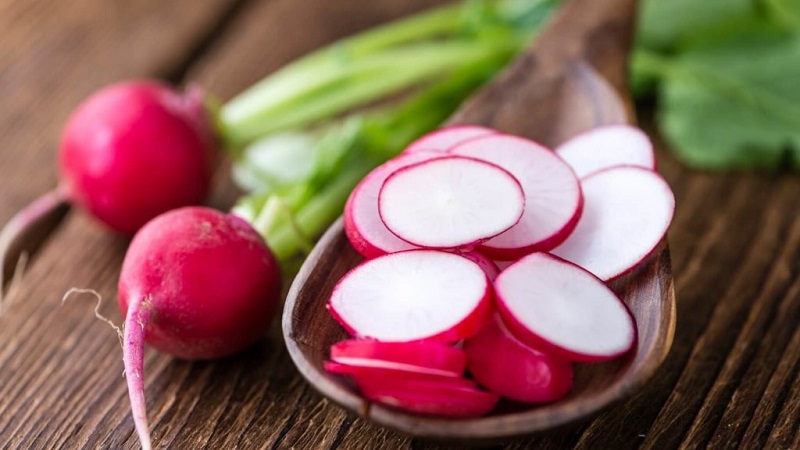
Radish is beneficial for the cardiovascular system... It strengthens the walls of blood vessels, increases their elasticity, normalizes the fluidity and viscosity of blood, reduces the tendency of platelets to stick together, which serves as a good prevention of atherosclerosis, thrombophlebitis. Fruits support the normal functioning of the myocardium, reduce the load on the heart, prevent the occurrence of stroke, myocardial infarction.
Calcium in composition is important for teeth and bones. The macronutrient promotes the mineralization of bone tissue and prevents its destruction, increases bone density, and also ensures the stable functioning of the cardiovascular system.
Magnesium and potassium normalize blood pressure, regulate water and electrolyte balance, and improve the process of neuromuscular transmission. Zinc promotes hair regeneration and growth, copper - prevents the development of anemia, hypoxia of organs and tissues, ascorbic acid - participates in the processes of regulation of tissue regeneration, carbohydrate metabolism.
Benefits and harms for various diseases
Radish has a unique chemical composition, thanks to which it is used for the treatment and prevention of a wide range of diseases. Fruits must be present in the diet of people with hypovitaminosis.Regular consumption of vegetables to a certain extent compensates for the deficiency of calcium, potassium, magnesium, sodium, iron, zinc, vitamin B, vitamin A, C and E.
Useful radish for obesity, dysfunction of the gastrointestinal tract... It cleanses the body of toxins and toxins, activates intestinal peristalsis, normalizes metabolic processes, dulls the feeling of hunger, and has a laxative effect.
Radish is used as a prophylactic agent for cardiovascular pathologies.... It improves the viscosity and fluidity of blood, stimulates blood supply, protects tissues and organs from aggressive radicals, regulates blood glucose levels, and lowers cholesterol.

Radish is included in the menu of patients suffering from headaches, back and joint pain, rheumatic diseases. By increasing the formation and excretion of urine together with crystals of uric acid salts, tops and fruits are used to prevent relapses and exacerbations of gout.
Radish helps with constipation, loss of appetite, normalizes night sleep, improves mood, acts as a sedative on the nervous system, reduces the effects of stress.
Another indication for eating radishes - rickets in children. The vegetable restores disturbed mineral metabolism, increases bone density, and reduces bone resorption.
For respiratory diseasesaccompanied by cough (bronchitis, tonsillitis, flu), radish shortens the recovery time, enhances the effect of drugs, strengthens the immune system, prevents the spread of infection into the lower respiratory tract, reduces the frequency and intensity of coughing.
Fruits and tops have diuretic properties and are used to treat diseases of the urinary system. Indications for the use of a vegetable are puffiness, nephrotic syndrome, high blood pressure, hypercalcemia.
Important. You shouldn't buy radishes earlier than April and later than September. Fruits grown outside of the ripening period in nature contain toxic pesticides added to accelerate the growth and maturation of vegetables.
What is useful for men and women
Leaves and roots contain zinc, which takes an active part in the production of testosterone - the main male sex hormone. It increases muscle mass, is involved in the development of male genital organs, secondary male sexual characteristics. In women, testosterone is responsible for the distribution of adipose tissue, is responsible for the maturation of follicles during ovulation, and regulates sex drive and sexual health.
B vitamins, which are rich in radish fruits, relieve symptoms in the premenopausal and postmenopausal period, stop cardiovascular disorders provoked by hormonal disruption. Folic acid in the composition of the fruit is necessary for the normal growth and development of organs and tissues in the fetus.
Application for weight loss
The obvious advantage of radish for weight loss is low calorie content (20 kcal)... It practically does not contain fats, but it contains carbohydrates, proteins, pectin, which are necessary for cleansing the body. In addition, plant fiber removes excess water from the body, due to which puffiness decreases, and body volume decreases. The product has a slight laxative effect.
For reference. For weight loss, use radish juice. It must be consumed within 21 days, 200 ml.
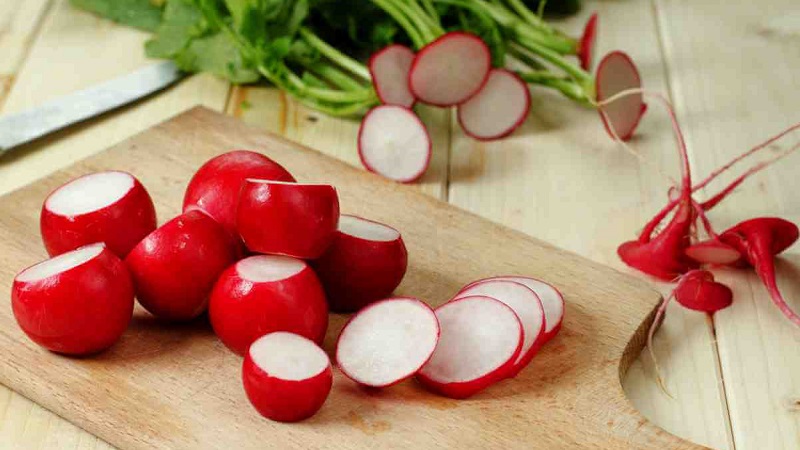
Rules and norms of use
The daily norm of a vegetable depends on the state of the digestive system, the presence of contraindications, age. On average, a healthy person is recommended to eat no more than 100-200 g of radish per day. You can not eat fruits every day, the optimal amount is 2-3 times a week.
Consume fresh fruits... However, in order to reduce the load on the digestive tract, roots can be doused with boiling water.If you soak a radish in cold water for 1-2 hours, the amount of harmful substances in it will decrease.
For reference... Radish with tops is stored in the refrigerator for 7 days, root crops without leaves - no more than 5 days.
The use of radish in cooking
Fresh root vegetables are used in cooking... They are used as an independent product, for example, for a snack, or as an addition to main courses. It is added as an ingredient to okroshka, vegetable salads, to sandwiches, processed into juice, canned, and salted. Fresh radish is added to the dish immediately before use, since after half an hour its beneficial properties are lost, the taste changes.
Fresh radish foliage has also found uses in cooking - in salads, okroshka, soups. Some housewives dry the foliage, grind it, then use it as an aromatic seasoning for cold and hot dishes.
Note to hostesses:
Top 8 best pickled radish recipes for the winter
Harvesting radishes for the winter: simple and delicious recipes for healthy snacks
In folk medicine
Radish tops are especially popular in folk medicine.... Decoctions and infusions are prepared from it, which are taken orally or used for external use in the form of compresses, lotions.
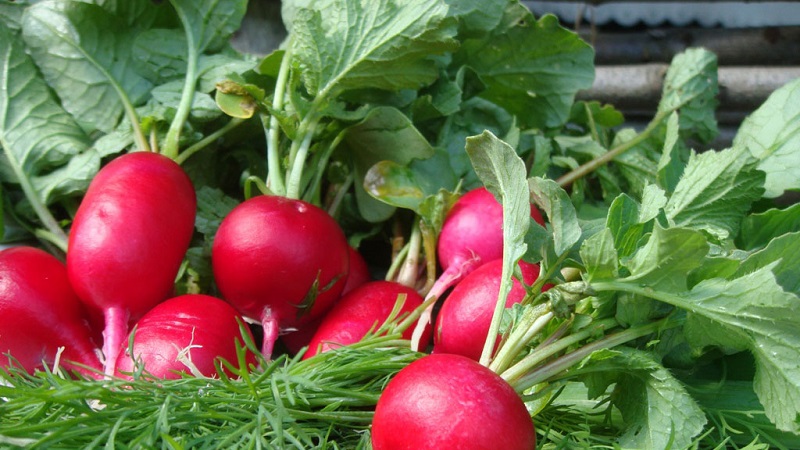
Infusion recipe:
- Rinse 20 g of leaves, remove the remaining water with a paper towel, chop finely.
- Pour 250 ml of hot water over the tops. Insist covered for about an hour.
- Strain the infusion through a sieve or several layers of gauze.
- If the medicine is for oral administration, a little sugar or honey can be added to improve the taste.
For the treatment of headaches, back pain, joints, compresses are made... The fabric folded in several layers, moisten in the infusion, wring out, attach to the problem area. Cover the top with polyethylene, attach to the body with several turns of the bandage, wrap it with a warm scarf. Root gruel, applied to the site of an insect bite, relieves itching, prevents the occurrence of an allergic reaction.
If the infusion is diluted with water in equal proportions, you get an effective cough medicine. Gargle several times a day. You can also take the infusion inside.
Radish roots are used in cosmetology... They help relieve fatigue, neutralize swelling, and improve skin color and condition. The vegetable slows down the aging process, moisturizes the skin well, tones up. To do this, it is enough in a day or two to wipe a clean, dry face with half a radish.
You can prepare a mask:Grind 3-4 medium root vegetables with the peel on a grater or in a blender until mushy, add 1 tbsp. essential oil of your choice, apply the mask to your face. After 15 minutes, wash off with water at room temperature.
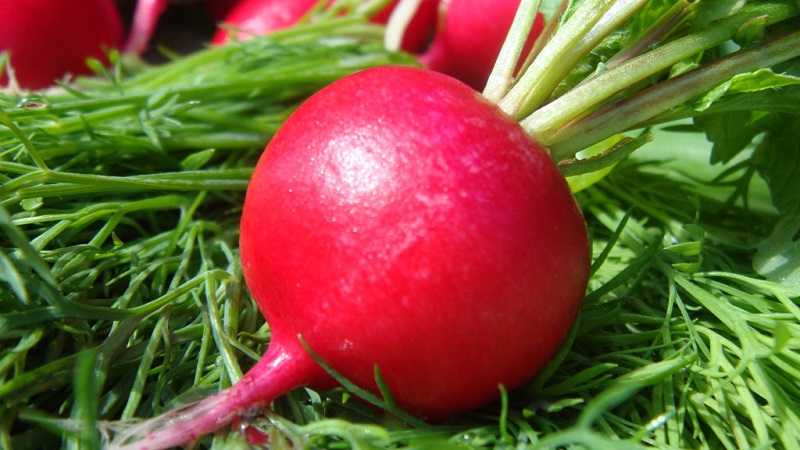
To whom is radish contraindicated?
Absolute contraindication for radish - individual intolerance one or more components of the composition. It is recommended to use root crops with caution for people with gastric ulcer and duodenal ulcer, gastritis, enterocolitis, especially during an exacerbation. You cannot eat radishes if you have an intestinal disorder, after a recent stroke or heart attack.
Is it possible for radishes for children
Radishes are not recommended for children under 2 years of age.... The composition contains acids that can irritate the mucous membrane, causing pain and discomfort in the lower abdomen. Due to the content of mustard oil, the fruits have a specific bitterness, so the child may not appreciate the taste of the vegetable.
To introduce a child to radishes, it is better to use it together with other vegetables., for example, grate into a salad on a fine grater. For the first time, ¼ part of the root crop will be enough. If the product is well absorbed, there are no side effects and allergies, then the rate is gradually increased. Children under three years of age are advised to eat no more than 40 g of radish per day with a frequency of 2-3 times a week, after the age of three - 50-100 g.
Is it possible during pregnancy and HB
Radish is on the list of useful foods during pregnancy... It saturates the female body with B vitamins, vitamin C, E, K, PP, macro- and microelements, which are necessary not only for the health of the expectant mother, but also provide favorable conditions for the normal growth and development of tissues and organs of the embryo.
Folic acid is especially useful in the composition... Even a short-term deficiency can cause disruption of the normal development of the nervous system in the fetus. In case of insufficient intake of folic acid, there is a threat of partial detachment of the placenta, miscarriage, stillbirth, and fetal growth retardation.
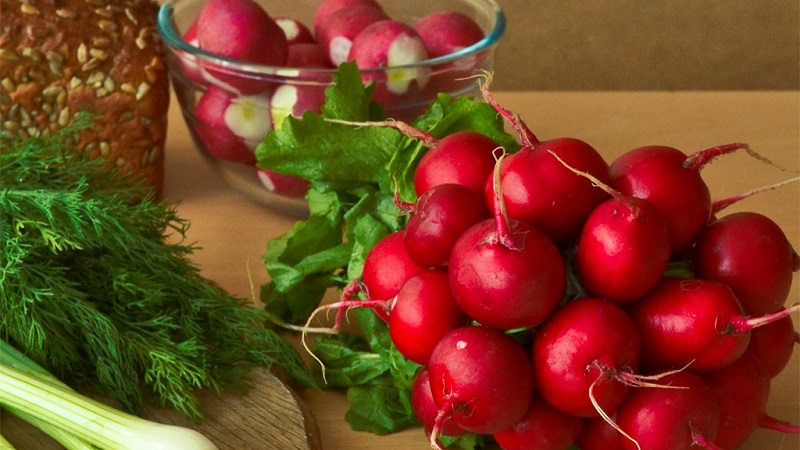
Other beneficial properties of radish for pregnant women are in antimicrobial action, the ability to neutralize puffiness, strengthen the immune system, normalize stool, improve the functioning of the digestive tract. In order to get the maximum benefit for the body without a threat to health, it is important to observe the measure, not to consume the vegetable at night.
Breastfeeding consultants recommend eliminating radishes from your diet nursing mom. The product is difficult to digest and can provoke in a child increased gas production, colic, bloating, even a spasm. After the child is six months old, you can gradually and in limited quantities introduce radishes into the mother's diet.
Important. The most useful will be a radish of its own harvest, grown without the use of nitrates. If such a condition is not feasible, it is necessary to buy the "correct" radish. Good fruits have a smooth, shiny peel without traces of spoilage and blackheads, elastic to the touch.
Conclusion
Radish is a valuable food product. In addition to nutritional qualities, dietary and medicinal properties are inherent in the roots and leaves of the plant. Radish is recommended to be used for the treatment and prevention of diseases of the heart, blood vessels, organs of the digestive, respiratory, and urinary systems.
Despite all its usefulness, the vegetable can pose a health threat. In large quantities, even in a healthy person, it causes discomfort, a feeling of heaviness in the abdomen, and upset stools. In children, undesirable effects are manifested by increased gas production, colic, and a local allergic reaction. Therefore, it is important to observe the rules and regulations for the use of radish, and use it as a medicine after consultation with a specialist.